The Interaction of Waterborne Epoxy/Dicyandiamide Varnishes with Metal Oxides
Abstract
:1. Introduction
2. Materials and Methods
2.1. Materials and Sample Preparation
2.2. Analytical Characterization
3. Results and Discussion
3.1. Chemical Structure of Components for the Waterborne Epoxy Varnish
3.2. Metal Oxides and Their Interaction with DICY in an Aqueous Enviroment
- Al: Ra = 0.47 µm; Rz = 4.11 µm
- Zn: Ra = 0.25 µm; Rz = 3.12 µm
- Sn: Ra = 0.26 µm; Rz = 6.75 µm
3.2.1. Effect of Immersion on XPS Spectra of Metal Substrates
3.2.2. Effect of Immersion on DICY Residues on Metal Substrates
3.3. Interphase Formation during Coating of Metal Substrates with Waterborne Epoxy Varnishes
3.3.1. Structural Features of ULAM Cuts
3.3.2. Elemental Composition of Epoxy Coatings on Metal Substrates
3.3.3. Chemical Changes near the Interface
4. Summary and Conclusions
Author Contributions
Funding
Institutional Review Board Statement
Informed Consent Statement
Data Availability Statement
Acknowledgments
Conflicts of Interest
References
- Nothdurft, P.; Riess, G.; Kern, W. Copper/Epoxy Joints in Printed Circuit Boards: Manufacturing and Interfacial Failure Mechanisms. Materials 2019, 12, 550. [Google Scholar] [CrossRef] [PubMed] [Green Version]
- Wegmann, A. Chemical resistance of waterborne epoxy/amine coatings. Prog. Org. Coat. 1997, 32, 231–239. [Google Scholar] [CrossRef]
- Neisiany, R.E.; Khorasani, S.N.; Lee, J.K.Y.; Ramakrishna, S. Encapsulation of epoxy and amine curing agent in PAN nanofibers by coaxial electrospinning for self-healing purposes. RSC Adv. 2016, 6, 70056–70063. [Google Scholar] [CrossRef]
- Tabish, M.; Zhao, J.; Wang, J.; Anjum, M.J.; Qiang, Y.; Yang, Q.; Mushtaq, M.A.; Yasin, G. Improving the corrosion protection ability of epoxy coating using CaAl LDH intercalated with 2-mercaptobenzothiazole as a pigment on steel substrate. Prog. Org. Coat. 2022, 165, 106765. [Google Scholar] [CrossRef]
- Zhang, S.; Park, J.; Paik, K.-W. Joint Morphologies and Failure Mechanisms of Anisotropic Conductive Films (ACFs) During a Power Handling Capability Test for Flex-On-Board Applications. IEEE Trans. Compon. Packag. Manuf. Technol. 2016, 6, 1820–1826. [Google Scholar] [CrossRef]
- Kim, T.-W.; Lee, T.-I.; Pan, Y.; Kim, W.; Zhang, S.; Kim, T.-S.; Paik, K.-W. Effect of Nanofiber Orientation on Nanofiber Solder Anisotropic Conductive Films Joint Properties and Bending Reliability of Flex-on-Flex Assembly. IEEE Trans. Compon. Packag. Manuf. Technol. 2016, 6, 1317–1329. [Google Scholar] [CrossRef]
- Bengu, B.; Boerio, F.J. Interaction of Epoxy/Dicyandiamide Adhesives with Metal Substrates. J. Adhes. 2006, 82, 1133–1155. [Google Scholar] [CrossRef]
- Raetzke, K.; Shaikh, M.Q.; Faupel, F.; Noeske, P.-L.M. Shelf stability of reactive adhesive formulations: A case study for dicyandiamide-cured epoxy systems. Int. J. Adhes. Adhes. 2010, 30, 105–110. [Google Scholar] [CrossRef]
- Aufray, M.; Roche, A.A. Epoxy–amine/metal interphases: Influences from sharp needle-like crystal formation. Int. J. Adhes. Adhes. 2007, 27, 387–393. [Google Scholar] [CrossRef] [Green Version]
- Aufray, M.; Roche, A.A. Properties of the Interphase Epoxy–Amine/Metal: Influences from the Nature of the Amine and the Metal. In Adhesion; Possart, W., Ed.; WILEY-VCH Verlag GmbH & Co. KGaA: Weinheim, Germany, 2005; pp. 89–102. [Google Scholar]
- Ballerini, G.; Ogle, K.; Barthés-Labrousse, M.-G. The acid–base properties of the surface of native zinc oxide layers: An XPS study of adsorption of 1,2-diaminoethane. Appl. Surf. Sci. 2007, 253, 6860–6867. [Google Scholar] [CrossRef]
- Barthés-Labrousse, M.-G. Mechanisms of Formation of the Interphase in Epoxy-Amine/Aluminium Joints. J. Adhes. 2012, 88, 699–719. [Google Scholar] [CrossRef]
- Barthés-Labrousse, M.-G.; Mercier, D.; Debontridder, F. Formation of the Interphase in Epoxy-Amine/Aluminium Joints: From surface corrosion to metal bonding. In Surface Properties and Engineering of Complex Intermetallics; Belin-Ferré, E., Ed.; World Scientific Publishing Co. Pte. Ltd.: Hackensack, NJ, USA, 2010; Volume 3, pp. 265–291. [Google Scholar]
- Marchfelder, C.; Pugstaller, R.; Wallner, G.; Brüggemann, O.; Aufray, M. Effect of Epoxy Structure on Properties of Waterborne Coatings and Electrical Steel Laminates. Polymers 2022, 14, 1556. [Google Scholar] [CrossRef] [PubMed]
- Greunz, T.; Strauß, B.; Schausberger, S.E.; Heise, B.; Jachs, B.; Stifter, D. Cryo ultra-low-angle microtomy for XPS-depth profiling of organic coatings. Anal. Bioanal. Chem. 2013, 405, 7153–7160. [Google Scholar] [CrossRef] [PubMed]
- Greunz, T.; Duchaczek, H.; Sagl, R.; Duchoslav, J.; Steinberger, R.; Strauß, B.; Stifter, D. Quantification of the toxic hexavalent chromium content in an organic matrix by Xray photoelectron spectroscopy (XPS) and ultra-low-angle microtomy (ULAM). Appl. Surf. Sci. 2017, 396, 665–671. [Google Scholar] [CrossRef]
- Beamson, G.; Briggs, D. The XPS of Polymers Database; Surface Spectra: Manchester, UK, 2000. [Google Scholar]
- Graf, N.; Yegen, E.; Gross, T.; Lippitz, A.; Weigel, W.; Krakert, S.; Terfort, A.; Unger, W.E.S. XPS and NEXAFS studies of aliphatic and aromatic amine species on functionalized surfaces. Surf. Sci. 2009, 603, 2849–2860. [Google Scholar] [CrossRef]
- Ederer, J.; Janoš, P.; Ecorchard, P.; Tolasz, J.; Štengl, V.; Beneš, H.; Perchacz, H.; Pop-Georgievski, O. Determination of amino groups on functionalized graphene oxide for polyurethane nanomaterials: XPS quantitation vs. functional speciation. RSC Adv. 2017, 7, 12464–12473. [Google Scholar] [CrossRef] [Green Version]
- Jansen, R.J.J.; van Bekkum, H. XPS of nitrogen-containing functional groups on activated carbon. Carbon 1995, 33, 1021–1027. [Google Scholar] [CrossRef]
- Lin, K.; Yang, S.; Shi, Z.; Fan, Q.; Liu, Z.; Liu, L. Knitting a sweater with UV-induced in situ polymerization of poly(pyrrole-co-citral nitrile) on Ni-rich layer oxide cathode materials for lithium ion batteries. J. Power Sources 2022, 520, 230768. [Google Scholar] [CrossRef]
- Duchoslav, J.; Steinberger, R.; Arndt, M.; Stifter, D. XPS study of zinc hydroxide as a potential corrosion product of zinc: Rapid X-ray induced conversion into zinc oxide. Corros. Sci. 2014, 82, 356–361. [Google Scholar] [CrossRef]
- Drouet, C.; Salles, F.; Fritah, Z.; Marsan, O.; Thouron, C.; Aufray, M. Further insight on amine-metal reaction in epoxy systems. J. Surfin. 2021, 23, 100959. [Google Scholar] [CrossRef]
- Mercier, D.; Barthés-Labrousse, M.-G. The role of chelating agents on the corrosion mechanisms of aluminium in alkaline aqueous solutions. Corros. Sci. 2009, 51, 339–348. [Google Scholar] [CrossRef]
- Satoru, Y.; Keiji, T. Entropy-driven segregation in epoxy-amine systems at a copper interface. Soft Matter 2021, 17, 1359–1367. [Google Scholar]
- Aoki, M.; Shundo, A.; Okamoto, K.; Ganbe, T.; Tanaka, K. Segregation of an amine component in a model epoxy resin at a copper interface. Polym. J. 2019, 51, 359–363. [Google Scholar] [CrossRef]
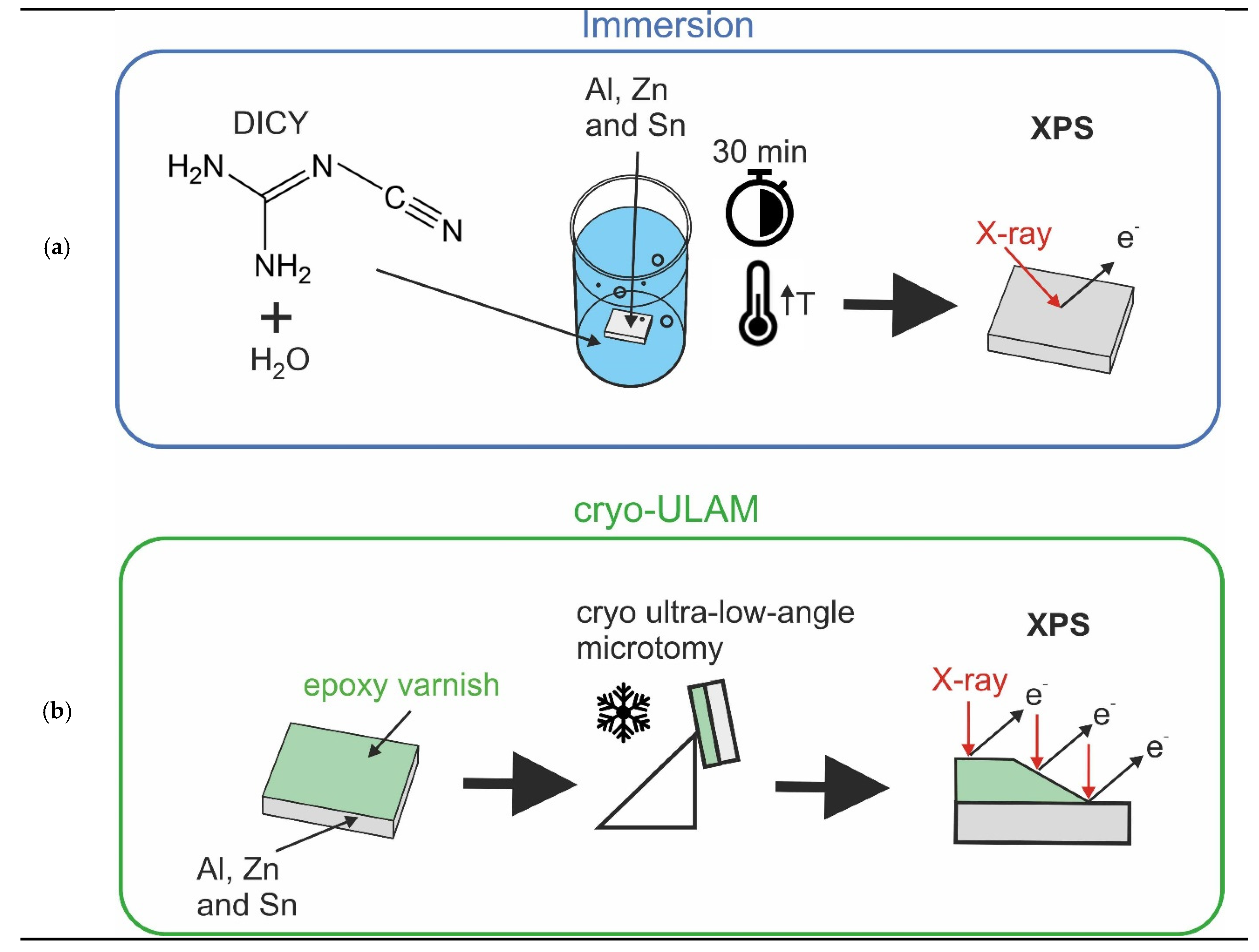
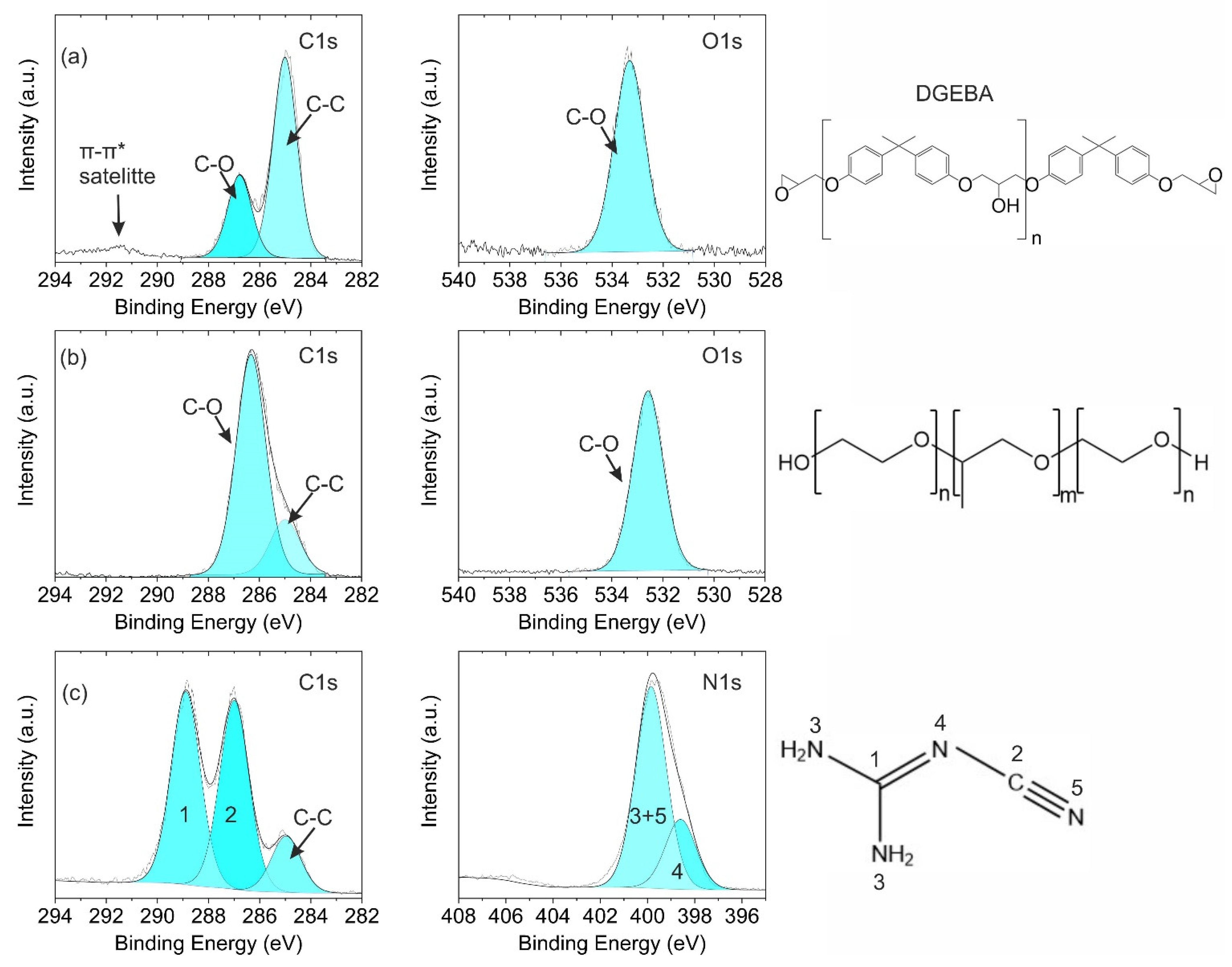

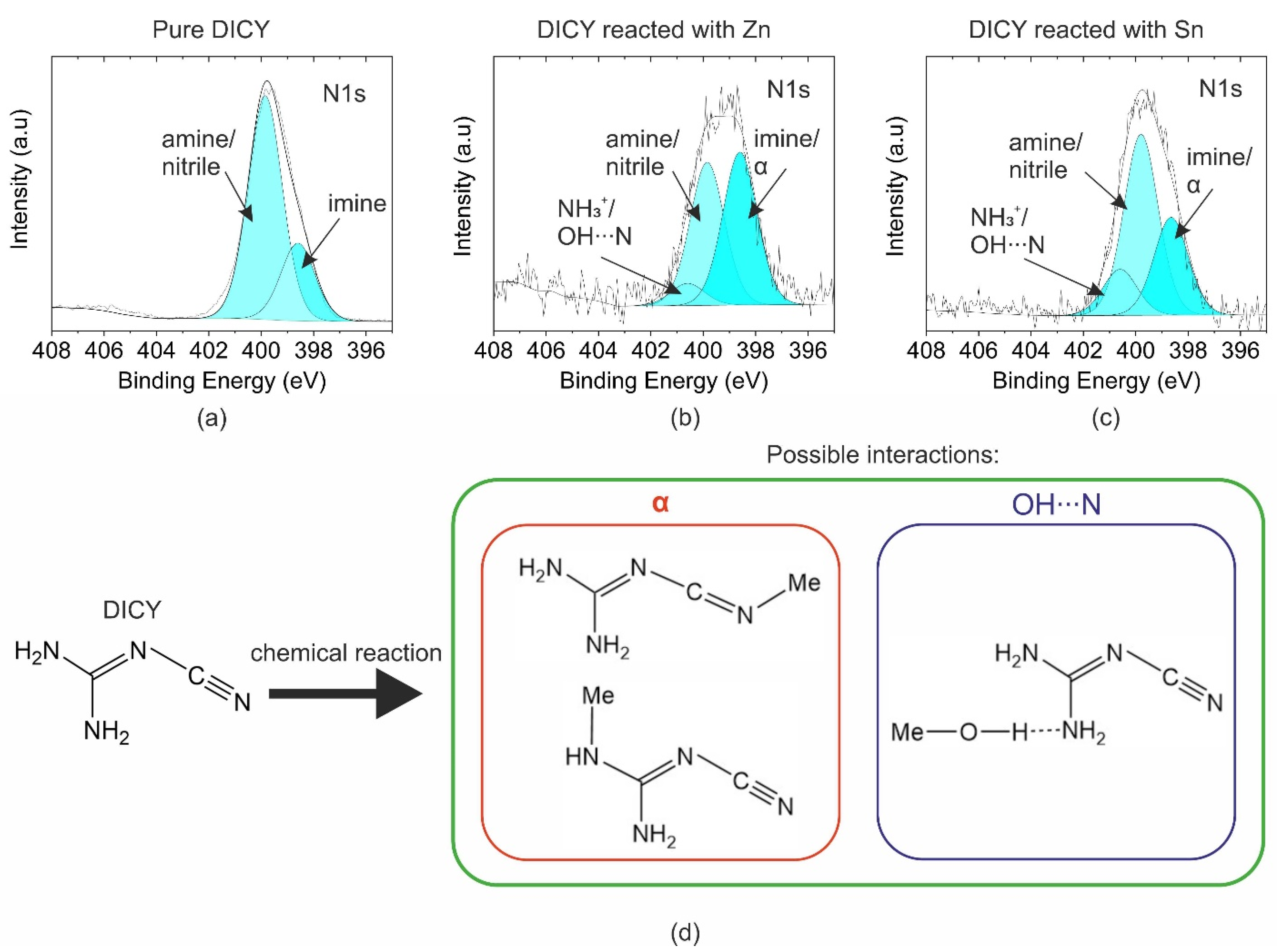
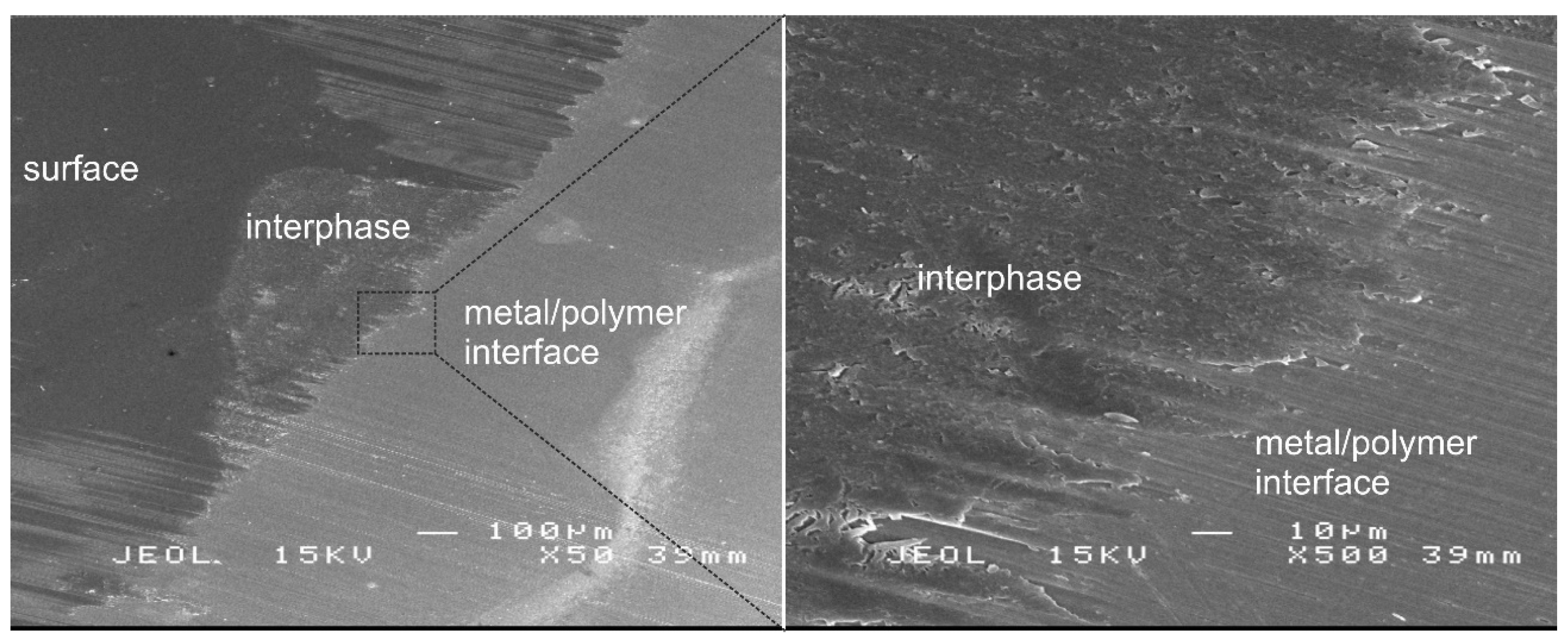
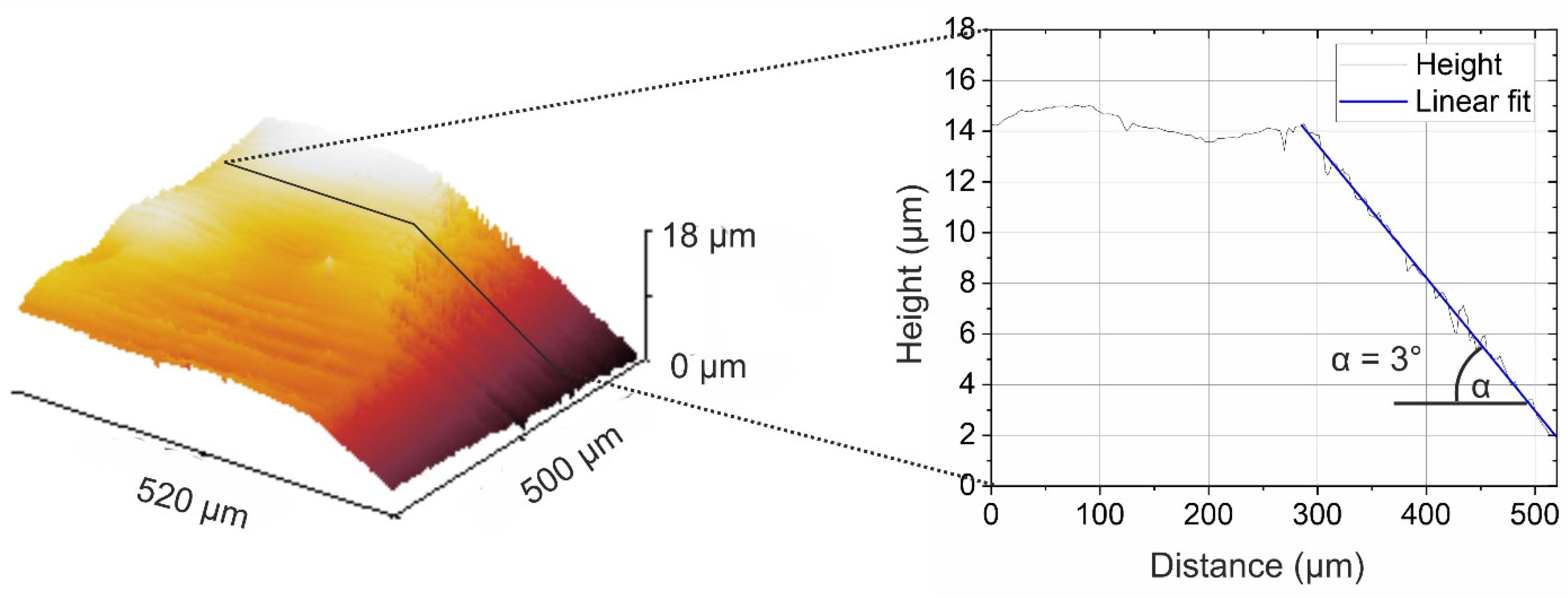
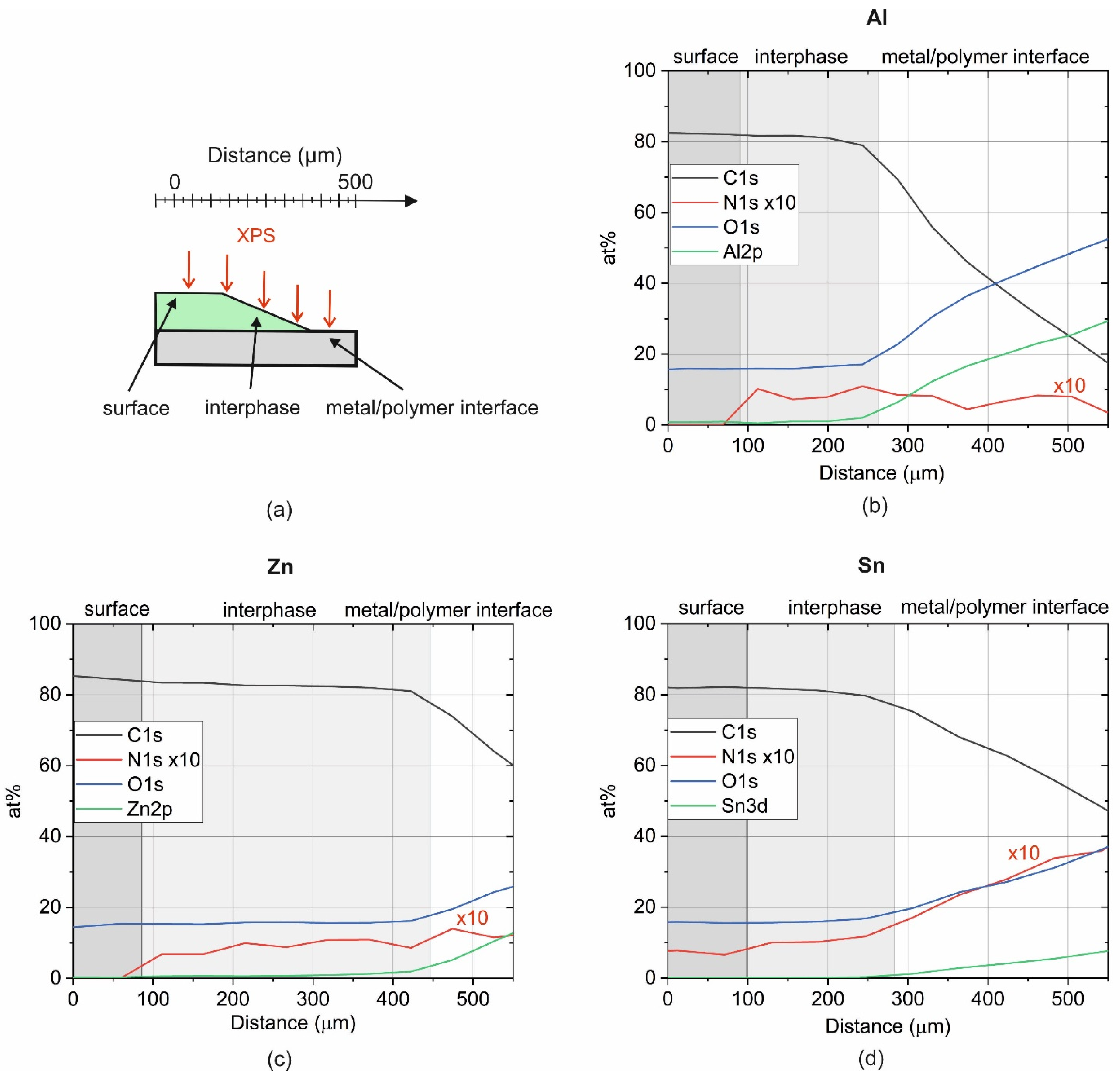
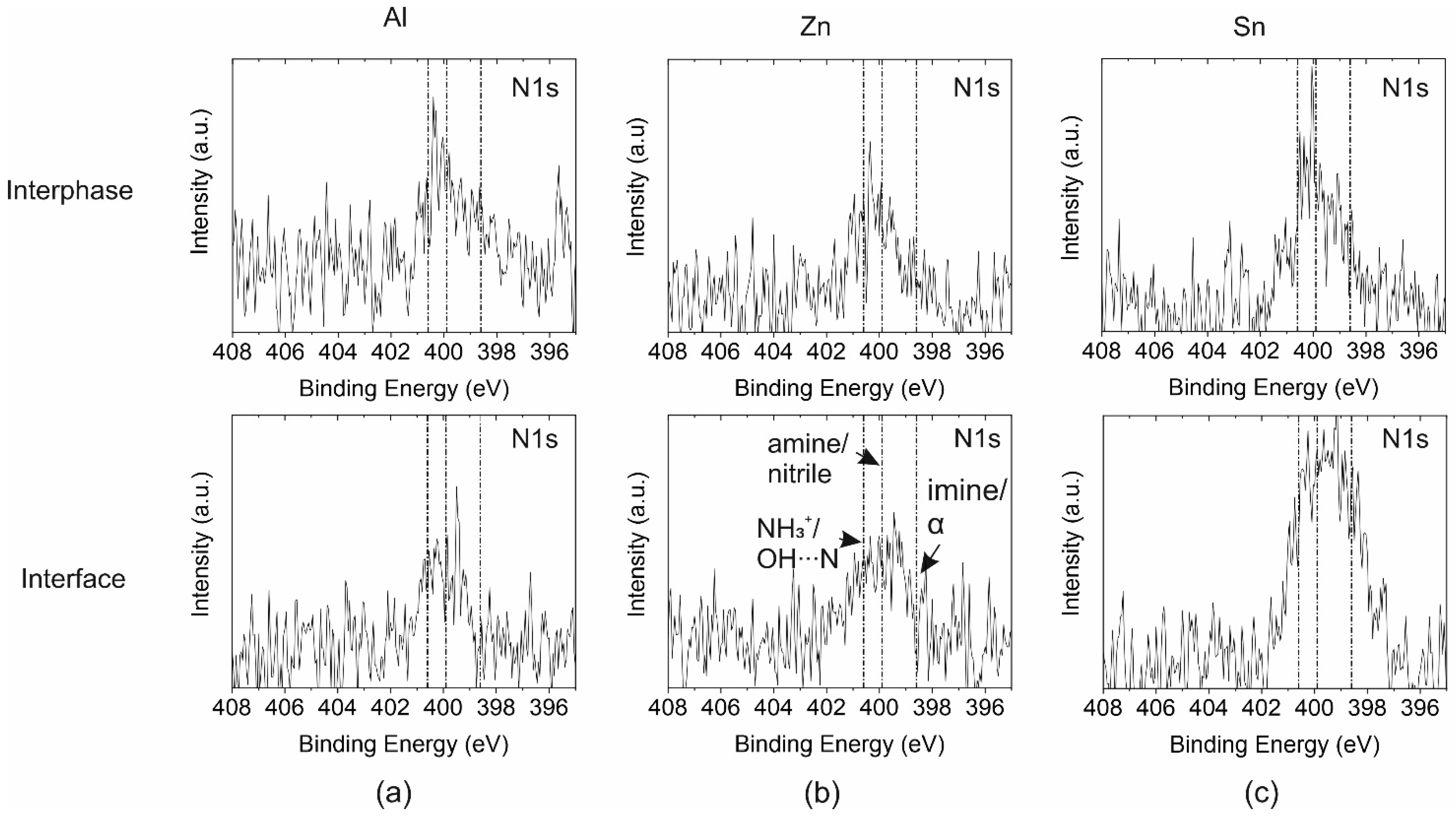
| C1s | N1s | O1s | |||||
|---|---|---|---|---|---|---|---|
| C-C | C-O | -C≡N (2) | C-N3 (1) | -C≡N/NH2 (3 + 5) | C=N-C (4) | C-O | |
| Epoxy | 285.0 (59.4 at%) | 286.8 (24.4 at%) | 533.2 (16.2 at%) | ||||
| Emulsifier | 285.0 (14.3 at%) | 286.4 (57.4 at%) | 532.6 (28.3 at%) | ||||
| DICY | 285.0 (4.7 at%) | 287.0 (16.0 at%) | 288.9 (16.4 at%) | 399.9 (46.7 at%) | 398.6 (16.2 at%) | ||
Publisher’s Note: MDPI stays neutral with regard to jurisdictional claims in published maps and institutional affiliations. |
© 2022 by the authors. Licensee MDPI, Basel, Switzerland. This article is an open access article distributed under the terms and conditions of the Creative Commons Attribution (CC BY) license (https://creativecommons.org/licenses/by/4.0/).
Share and Cite
Säckl, G.; Duchoslav, J.; Pugstaller, R.; Marchfelder, C.; Haselgrübler, K.; Aufray, M.; Stifter, D.; Wallner, G.M. The Interaction of Waterborne Epoxy/Dicyandiamide Varnishes with Metal Oxides. Polymers 2022, 14, 2226. https://doi.org/10.3390/polym14112226
Säckl G, Duchoslav J, Pugstaller R, Marchfelder C, Haselgrübler K, Aufray M, Stifter D, Wallner GM. The Interaction of Waterborne Epoxy/Dicyandiamide Varnishes with Metal Oxides. Polymers. 2022; 14(11):2226. https://doi.org/10.3390/polym14112226
Chicago/Turabian StyleSäckl, Gary, Jiri Duchoslav, Robert Pugstaller, Cornelia Marchfelder, Klaus Haselgrübler, Maëlenn Aufray, David Stifter, and Gernot M. Wallner. 2022. "The Interaction of Waterborne Epoxy/Dicyandiamide Varnishes with Metal Oxides" Polymers 14, no. 11: 2226. https://doi.org/10.3390/polym14112226







